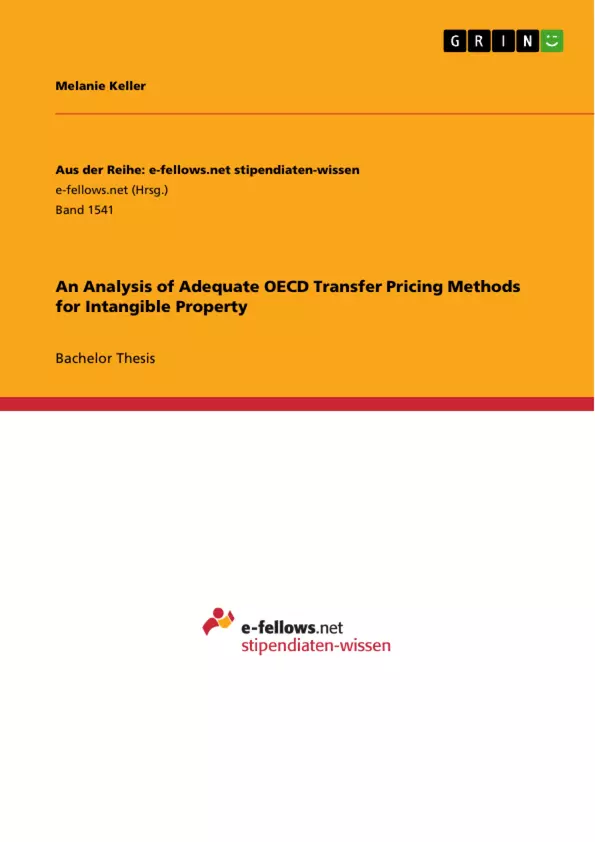
An Analysis of Adequate OECD Transfer Pricing Methods for Intangible Property
Bachelorarbeit, 2015
26 Seiten
Leseprobe
Inhaltsverzeichnis (Table of Contents)
- Introduction
- Problem Definition
- Aims and Non-Aims
- Methodology and Structure
- Definitions of intangible property and relevant TP methods
- Trade intangibles
- Marketing intangibles
- Comparable uncontrolled price method
- Resale price method
- Cost plus method
- The importance of intangible property for MNEs
- Transfer Pricing and its objectives
- Challenges of applying the ALP to intangible property
- Application and Limitations of OECD TP methods for intangible property
- Comparable uncontrolled price method
- Resale price method
- Cost plus method
- Transactional profit methods
- Conclusion
Zielsetzung und Themenschwerpunkte (Objectives and Key Themes)
This bachelor thesis aims to analyze the adequacy of OECD transfer pricing methods for intangible property, particularly focusing on the challenges of applying the arm's length principle (ALP) to intangible assets. The study explores the importance of intangible property for multinational enterprises (MNEs) and examines the application and limitations of various OECD transfer pricing methods in this context.
- The significance of intangible property for MNEs and its impact on their competitive advantage
- The challenges of applying the arm's length principle to intangible property
- The suitability of OECD transfer pricing methods for intangible assets
- The limitations of traditional transfer pricing methods when dealing with intangible property
- The importance of aligning transfer pricing strategies with corporate objectives and tax regulations
Zusammenfassung der Kapitel (Chapter Summaries)
The introduction outlines the problem definition, aims and non-aims of the thesis, and introduces key concepts such as intangible property and transfer pricing methods. It emphasizes the increasing importance of intra-firm trade and the need for appropriate transfer pricing strategies to ensure compliance with the arm's length principle.
The subsequent chapters delve into the significance of intangible property for MNEs, explore the objectives of transfer pricing, and discuss the challenges of applying the ALP to intangible assets. It analyzes the application and limitations of various OECD transfer pricing methods, including the comparable uncontrolled price method, resale price method, cost plus method, and transactional profit methods.
Schlüsselwörter (Keywords)
The primary focus of this thesis lies on intangible property, transfer pricing, arm's length principle, multinational enterprises (MNEs), OECD transfer pricing methods, comparable uncontrolled price method, resale price method, cost plus method, and transactional profit methods. The study examines the challenges and limitations of applying these methods to intangible assets and explores the implications for MNEs' competitive advantage and tax compliance.
Details
- Titel
- An Analysis of Adequate OECD Transfer Pricing Methods for Intangible Property
- Hochschule
- Management Center Innsbruck Internationale Fachhochschulgesellschaft mbH
- Autor
- Melanie Keller (Autor:in)
- Erscheinungsjahr
- 2015
- Seiten
- 26
- Katalognummer
- V303818
- ISBN (eBook)
- 9783668021938
- ISBN (Buch)
- 9783668021945
- Dateigröße
- 589 KB
- Sprache
- Englisch
- Schlagworte
- analysis adequate oecd transfer pricing methods intangible property
- Produktsicherheit
- GRIN Publishing GmbH
- Preis (Ebook)
- US$ 17,99
- Preis (Book)
- US$ 20,99
- Arbeit zitieren
- Melanie Keller (Autor:in), 2015, An Analysis of Adequate OECD Transfer Pricing Methods for Intangible Property, München, Page::Imprint:: GRINVerlagOHG, https://www.diplomarbeiten24.de/document/303818
- Autor werden
- Ihre Optionen
- Vertriebskanäle
- Premium Services
- Autorenprofil
- Textarten und Formate
- Services für Verlage, Hochschulen, Unternehmen

- © GRIN Publishing GmbH.
- Alle Inhalte urheberrechtlich geschützt. Kopieren und verbreiten untersagt.
- info@grin.com
- AGB
- Open Publishing
Der GRIN Verlag hat sich seit 1998 auf die Veröffentlichung akademischer eBooks und Bücher spezialisiert. Der GRIN Verlag steht damit als erstes Unternehmen für User Generated Quality Content. Die Verlagsseiten GRIN.com, Hausarbeiten.de und Diplomarbeiten24 bieten für Hochschullehrer, Absolventen und Studenten die ideale Plattform, wissenschaftliche Texte wie Hausarbeiten, Referate, Bachelorarbeiten, Masterarbeiten, Diplomarbeiten, Dissertationen und wissenschaftliche Aufsätze einem breiten Publikum zu präsentieren.
Kostenfreie Veröffentlichung: Hausarbeit, Bachelorarbeit, Diplomarbeit, Dissertation, Masterarbeit, Interpretation oder Referat jetzt veröffentlichen!
- GRIN Verlag GmbH
-
- Nymphenburger Str. 86
- 80636
- Munich, Deutschland
- +49 89-550559-0
- +49 89-550559-10
- info@grin.com
-









